The Source, Distribution, and Sedimentary Pattern of K-Rich Brines in the Qaidam Basin, Western China
Abstract
:1. Introduction
2. Description of the Study Area
2.1. Geological Setting of the QB
2.2. Geological Setting of the QSL
3. Materials and Methods
3.1. Sample Collection and Analytical Method
3.2. Data Analysis Methods
3.2.1. Flux Calculation
3.2.2. Forward Model to Quantify the Contribution of Different Sources to the Solutes of River Waters
4. Results
4.1. K+ Concentrations and TDS of Intercrystalline Brines in the QSL
4.2. K Flux Calculation
4.3. The Contributions of Four Sources to the Major Ions in Rivers
5. Discussion
5.1. The Source of K in the QSL from Flux Calculation Constraint
5.2. The Distribution and Sedimentary Pattern of Shallow Brines in the QB
5.3. The Distribution, Source and Sedimentary Pattern of Deep Brines in the QB
6. Conclusions
- (1)
- The K in shallow brines (surface brines and intercrystalline brines) in the QB are mainly from high–flux K input by rivers which achieve K from silicate weathering, rather than from the remnant of the “ancient Qaidam Lake.” The results calculated by using the forward model showed that evaporites contribute to most of the salt load (K+, Na+, Ca2+, and Mg2+) in rivers in the QSL, followed by the carbonate and silicate weathering.
- (2)
- The K+ concentrations of shallow brines (surface brines and intercrystalline brines) in the QB are uneven. The amount of river K recharge, the appropriate evaporation degree, and the mixture of river and spring waters jointly contribute to this phenomenon. The uneven K+ concentrations of brines in the QSL result from different river K recharge in different sections and isolated depressions.
- (2)
- The deep brines (pore brines and oilfield brines) are mainly distributed in the western QB. The water–salt interaction of original pore waters with the K-bearing evaporite layer (potash salts and/or K-rich intercrystalline brines) is the main reason for the formation of the K-rich pore brines. By contrast, the K in oilfield brines in the QB may be meteoric water, salt dissolution, and the mixing of hydrothermal fluids’ origins, and the conversion of clay minerals to K-feldspar may consume K in the oilfield brines.
Supplementary Materials
Author Contributions
Funding
Acknowledgments
Conflicts of Interest
References
- Liu, C.L.; Wang, L.C.; Yan, M.D.; Zhao, Y.J.; Cao, Y.T.; Fang, X.M.; Shen, L.J.; Wu, C.H.; Lv, F.L.; Ding, T. The Mesozoic–Cenozoic tectonic settings, paleogeography and evaporitic sedimentation of Tethyan blocks within China: Implications for potash formation. Ore Geol. Rev. 2018, 102, 406–425. [Google Scholar] [CrossRef]
- Warren, J.K. Evaporites through time: Tectonic, climatic and eustatic controls in marine and nonmarine deposits. Earth Sci. Rev. 2010, 98, 217–268. [Google Scholar] [CrossRef]
- Klingspor, A.M. Middle Devonian Muskeg evaporites of western Canada. AAPG Bull. 1969, 53, 927–948. [Google Scholar]
- Zhang, P.X. Salt Lake in Qaidam Basin; Science Press: Beijing, China, 1987. [Google Scholar]
- Hsü, J.H.; Qian, Z.H.; Lian, W.; Yuan, Z.; Chen, Y.C.; Wu, B.H.; Wang, M.L. Origin of potassium evaporation pump in Qarhan Salt Lake, China. Geol. Chem. Miner. 1991, 12, 1–28. [Google Scholar]
- Yang, Q.; Wu, B.H.; Wang, S.Z.; Cai, K.Q.; Qian, Z.H. Geology of Potassium Deposit in Qarhan Salt Lake; Science Press: Beijing, China, 1993. [Google Scholar]
- Yuan, J.Q.; Yang, Q.; Sun, D.P.; Huo, C.Y.; Cai, K.Q.; Wang, W.D.; Liu, X.J. The Formation Conditions of Potash Deposit in Qarhan Salt Lake; Geological Press: Beijing, China, 1995. [Google Scholar]
- Zheng, M.P.; Zhang, Y.S.; Liu, X.F.; Qi, W.; Kong, F.J.; Nie, Z.; Pu, L.Z.; Hou, X.H.; Wang, H.L.; Zhang, Z.; et al. Progress and prospect of salt lake research in China. Acta Geol. Sin. 2016, 4, 1195–1235. [Google Scholar] [CrossRef]
- Fan, Q.S.; Lowenstein, T.K.; Wei, H.C.; Yuan, Q.; Qin, Z.J.; Shan, F.S.; Ma, H.Z. Sr isotope and major ion compositional evidence for formation of Qarhan salt lake, western China. Chem. Geol. 2018, 497, 128–145. [Google Scholar] [CrossRef]
- Cao, W.H.; Wu, C. Brine Resources and the Technology of Their Comprehensive Utilization; Geology Press: Beijing, China, 2004. [Google Scholar]
- Yu, S.S.; Liu, X.Q.; Tan, H.B.; Cao, G.C. Sustainable Utilization of Qarhan Salt Lake Resources; Science Press: Beijing, China, 2009. [Google Scholar]
- Shi, Z.L.; Du, P.Y.; Wang, X.Q. Analysis and Study on Influential Factors of Potassium Chloride Production by Reverse Flotation. J. Salt Sci. Chem Ind. 2018, 47, 39–41. [Google Scholar]
- Zheng, M.P.; Hou, X.H.; Zhang, Y.S.; Xing, E.Y.; Li, H.P.; Yin, H.W.; Yu, C.Q.; Wang, N.J.; Deng, X.L.; Wei, Z.; et al. Progress in the investigation of potash resources in western China. Geol. China. 2018, 3, 392–401. [Google Scholar] [CrossRef]
- Fan, Q.S.; Ma, H.Z.; Tan, H.B.; Li, T.W.; Xu, J.X. Hydrochemical characteristics of brines and Potassium prospecting researches in Western Qaidam Basin. Acta Geosci. Sin. 2007, 5, 446–455. [Google Scholar]
- Fan, Q.S.; Ma, H.Z.; Lai, Z.P.; Tan, H.B.; Li, T.W. Origin and evolution of oilfield brines from Tertiary strata in western Qaidam Basin: Constraints from 87Sr/86Sr, δD, δ18O, δ34S and water chemistry. Chin. J. Geochem. 2010, 29, 446–454. [Google Scholar] [CrossRef]
- Tan, H.B.; Rao, W.B.; Ma, H.Z.; Chen, J.S.; Li, T.W. Hydrogen, oxygen, helium and strontium isotopic constraints on the formation of oilfield waters in the western Qaidam Basin, China. J. Asian Earth Sci. 2011, 40, 651–660. [Google Scholar] [CrossRef]
- Li, H.P.; Zheng, M.P.; Hou, X.H.; Sun, B.T.; Liu, G.T.; Dou, Q.C. Hydrochemistry characteristics and origin of new brine sandy gravel in early Pleistocene of Heibei concave in Qaidam Basin. Earth Sci. J. China Univ. Geosci. 2014, 10, 1433–1442. [Google Scholar]
- Li, H.P.; Zheng, M.P. Metallogenic characteristics of the potash deposit in deep brines in the western Qaidam Basin. Miner. Depos. 2014, 33, 935–936. [Google Scholar]
- Li, J.S.; Li, T.W.; Peng, X.M.; Han, Y.H.; Li, Z.P.; Ma, H.Z. Hydrogeochemical behaviors of oilfield water in the Tertiary in western Qaidam Basin. Oil Gas Geol. 2014, 1, 50–61. [Google Scholar]
- Li, H.P.; Zheng, M.P.; Hou, X.H.; Yan, L.J. Control factors and water chemical characteristics of potassium-rich deep brine in Nanyishan structure of western Qaidam Basin. Acta Geosci. Sin. 2015, 36, 41–50. [Google Scholar] [CrossRef]
- Yue, X.; Liu, X.X.; Lu, L.; Zhang, X.D.; Fan, Z.L.; Yu, X.L. Hydrochemical characteristics and origin of deep pore brine deposit in Mahai Baisn. Acta Sedimentol. Sin. 2019, 1, 1–12. [Google Scholar]
- Li, W.; Dong, Y.P.; Song, P.S. Development and Utilization of Salt Lake Brine Resources; Chemical Industry Press: Beijing, China, 2012. [Google Scholar]
- Guo, A.L.; Zhang, G.W.; Qiang, J.; Li, G.; Yao, A.P. An Indosinian Orogenic Belt in the Northeastern Qinghai–Tibet Plateau, China: Geochemical and Geochronological Evidence. Geochim. Cosmochim. Acta. 2008, 72, A335. [Google Scholar]
- Tan, H.B.; Chen, J.; Rao, W.B.; Zhang, W.J.; Zhou, H.F. Geothermal constraints on enrichment of boron and lithium in salt lakes: An example from a river–salt lake system on the northern slope of the eastern Kunlun Mountains, China. J. Asian Earth Sci. 2012, 51, 21–29. [Google Scholar] [CrossRef]
- Yin, A.; Rumelhart, P.; Butler, R.; Cowgill, E.; Harrison, T.; Foster, D.; Ingersoll, R.; Zhang, Q.; Zhou, X.Q.; Wang, X.F. Tectonic history of the Altyn Tagh fault system in northern Tibet inferred from Cenozoic sedimentation. Geol. Soc. Am. Bull. 2012, 114, 1257–1295. [Google Scholar] [CrossRef]
- Chen, K.Z.; Bowler, J.M. Late Pleistocene evolution of salt lakes in the Qaidam Basin, Qinghai Province, China. Paleogeogr. Paleoclimatol. Paleoecol. 1986, 54, 87–104. [Google Scholar]
- Zhang, P.X.; Zhang, B.Z.; Lowenstein, T.K.; Spencer, R.J. Origin of Ancient Anomalous Potassium Evaporites; Science Press: Beijing, China, 1993. [Google Scholar]
- Fan, Q.S.; Ma, H.Z.; Wei, H.C.; Shan, F.S.; An, F.Y.; Xu, L.M.; Madsen, D.B. Late Pleistocene paleoclimatic history documented by an oxygen isotope record from carbonate sediments in Qarhan Salt Lake, NE Qinghai–Tibetan Plateau. J. Asian Earth Sci. 2014, 85, 202–209. [Google Scholar] [CrossRef]
- Fan, Q.S.; Ma, H.Z.; Ma, Z.B.; Wei, H.C.; Han, F.Q. 2014b. An assessment and comparison of 230Th and AMS 14C ages for lacustrine sediments from Qarhan Salt Lake area in arid western China. Environ. Earth Sci. 2014, 71, 1227–1237. [Google Scholar] [CrossRef]
- Cai, K.Q.; Gao, J.H. Formation conditions of potassium deposit in Qarhan Salt Lake. Geosci. Front. 1994, 1, 3–4. [Google Scholar]
- Duan, Z.H.; Yuan, J.Q. The origin of saline materials of Qarhan Salt Lake in Qaidam Basin, China. Geoscience 1988, 4, 420–428. [Google Scholar]
- Lowenstein, T.K.; Spencer, R.J.; Zhang, P.X. Origin of ancient potash evaporites: Clues from the modern nonmarine Qaidam Basin of western China. Science 1989, 245, 1090–1092. [Google Scholar] [CrossRef]
- Lowenstein, T.K.; Risacher, F. Closed basin brine evolution and the influence of Ca–Cl inflow waters: Death Valley and Bristol Dry Lake California, Qaidam Basin, China, and Salar de Atacama, Chile. Aquetic Geochem. 2009, 15, 71–94. [Google Scholar] [CrossRef]
- Wang, S.J. Prospects for tapping the resources of the Qarhan Salt Lake. Geol. Chem. Miner 1999, 3, 175–180. [Google Scholar]
- Wang, C.N.; Guo, X.H.; Ma, M.Z.; Li, J.D. Ore–forming geological background of K–Mg salt in Qarhan Salt Lake. Northwest. Geol. 2008, 1, 97–106. [Google Scholar]
- Qinghai Institute of Salt Lakes. Methods for Analysis of Brine and Salt; Science Press: Beijing, China, 1973. [Google Scholar]
- Noh, H.; Hub, Y.; Qin, J.H.; Ellis, A. Chemical weathering in the Three Rivers region of Eastern Tibet. Geochim. Cosmochim. Acta. 2009, 73, 1857–1877. [Google Scholar] [CrossRef]
- Xiao, J.; Jin, Z.D.; Ding, H.; Wang, J.; Zhang, F. Geochemistry and solute sources of surface waters of the Tarim River Basin in the extreme arid region, NW Tibetan Plateau. J. Asian Earth Sci. 2012, 54, 162–173. [Google Scholar] [CrossRef]
- Wu, W.H. Hydrochemistry of inland rivers in the north Tibetan Plateau: Constraints and weathering rate estimation. Sci. Total Environ. 2016, 541, 468–482. [Google Scholar] [CrossRef] [PubMed]
- Galy, A.; France–Lanord, C. Weathering processes in the Ganges–Brahmaputra basin and the riverine alkalinity budget. Chem. Geol. 1999, 159, 31–60. [Google Scholar] [CrossRef]
- Moon, S.; Huh, Y.; Qin, J.; Van Pho, N. Chemical weathering in the Hong Red River basin: Rates of silicate weathering and their controlling factors. Geochim. Cosmochim. Acta 2007, 71, 1411–1430. [Google Scholar] [CrossRef]
- Jiang, H.; Liu, W.J.; Xu, Z.F.; Zhou, X.D.; Zheng, Z.Y.; Zhao, T.; Zhou, L.; Zhang, X.; Xu, Y.F.; Liu, T.Z. Chemical weathering of small catchments on the Southeastern Tibetan Plateau I: Water sources, solute sources and weathering rates. Chem. Geol. 2018, 500, 159–174. [Google Scholar] [CrossRef]
- Xu, Z.; Liu, C.Q. Water geochemistry of the Xijiang basin rivers, South China: Chemical weathering and CO2 consumption. Appl. Geochem. 2010, 25, 1603–1614. [Google Scholar] [CrossRef]
- Stallard, R.F.; Edmond, J.M. Geochemistry of the Amazon: 2. The influence of geology and weathering environment on the dissolved load. J. Geophys. Res. 1983, 88, 9671–9688. [Google Scholar] [CrossRef]
- White, A.F.; Blum, A.E. Effect of climate on chemical weathering in watersheds. Geochim. Cosmochim. Acta 1995, 59, 1729–1747. [Google Scholar] [CrossRef]
- Gaillardet, J.; Dupre, B.; Louvat, P.; Allegre, C.J. Global silicate weathering and CO2 consumption rates deduced from the chemistry of large rivers. Chem. Geol. 1999, 159, 3–30. [Google Scholar] [CrossRef]
- Tan, H.B.; Liu, X.Q.; Yu, S.S.; Lyu, Y.P. Character of Hydrochemistry in Golmud River–Dabsan Lake Water. J. Lake Sci. 2001, 13, 43–50. [Google Scholar]
- Du, Z.M. Hydrochemical changes of waters from the upper–middle reaches of Golmud river and their influencing factors. J. Salt Lake Res. 2018, 1, 25–31. [Google Scholar]
- Zhu, Y.Z.; Li, Z.Y.; Wu, B.H.; Wang, M.L. The formation of the Qarhan saline lakes as viewed from the Neotectonic movement. Acta Geol. Sin. 1990, 1, 13–21. [Google Scholar]
- Zhu, Y.Z.; Zhong, J.H.; Li, W.S. Neotectonic Movement and Evolution of Saline Lakes in the Qaidam Basin; Geological Press: Beijing, China, 1994. [Google Scholar]
- Liu, C.L.; Wang, M.L. Evaluation of Quaternary depositional environments and forming of potash deposits in Lop lake, Xinjiang, China. Acta Geosci. Sin. 1999, 20, 264–270. [Google Scholar]
- Chen, K.Z.; Yang, S.X.; Zheng, X.Y. Salt lakes in the Tebet Plateau. Acta Geol. Sin. 1981, 1, 13–21. [Google Scholar]
- Guo, P.; Liu, C.Y.; Huang, L.; Yu, M.L.; Wang, P.; Zhang, G.Q. Palaeohydrological evolution of the late Cenozoic saline lake in the Qaidam Basin, NE Tibetan Plateau: Tectonic vs. climatic control. Glob. Planet. Chang. 2018, 165, 44–61. [Google Scholar] [CrossRef]
- Yuan, J.Q.; Huo, C.Y. Genesis of the sylvinite deposits in the Qarhan Salt Lake, Qinghai province. Earth Sci. 1981, 1, 207–213. [Google Scholar]
- Yu, J.Q.; Gao, C.L.; Cheng, A.Y. Geomorphic, hydroclimatic and hydrothermal controls on the formation of lithium brine deposits in the Qaidam Basin, northern Tibetan Plateau, China. Ore Geol. Rev. 2013, 50, 171–183. [Google Scholar] [CrossRef]
- Craig, H. Isotopic variations in meteoric waters. Science 1961, 133, 1702–1703. [Google Scholar] [CrossRef] [PubMed]
- Xiao, Y.; Shao, J.L.; Frape, S.K.; Cui, Y.L.; Dang, X.Y.; Wang, S.B.; Ji, Y.H. Groundwater origin, flow regime and geochemical evolution in arid endorheic watersheds: A case study from the Qaidam Basin, northwestern China. Hydrol. Earth Syst. Sci. 2018, 22, 4381–4400. [Google Scholar] [CrossRef]
- Xu, W. Groundwater Cycle Patterns and its Response to Human Activities in Nalenggele Alluvial–Proluvial Plain. Ph.D. Thesis, Jilin University, Changchun, China, 2015. [Google Scholar]
- Carpenter, A.B. Origin and Chemical Evolution of Brines in Sedimentary Basins. Proceedings of the SPE Annual Fall Technical Conference and Exhibition, Houston, TX, USA, 1–3 October 1978; Ohnson, K.S., Russell, J.A., Eds.; Society of Petroleum Engineers: Houston, TX, USA, 1978; pp. 60–77. [Google Scholar]
- Xu, C. Preliminary study on clay minerals and their significance in sediment profile of some salt lakes in Qaidam Basin. Acta Sedimentol. Sin. 1983, 3, 123–127. [Google Scholar]
- Bjorkum, G. A chemical model of the formation of authigenic kaolinite, potassium feldspar, and illite in sediments. Transl. Geol. Sci. 1989, 3, 6–11. [Google Scholar]
- Gao, X. Clay Mineralogy; Chemical Industry Press: Beijing, China, 2017. [Google Scholar]
- Kharaka, Y.K.; Gunter, W.D.; Aggarwal, P.K.; Perkins, E.H.; Debraal, J.D. A Computer Program for Geochemical Modeling of Water–Rock Interations; USGS Water Resources Invest: Menlo Park, CA, USA, 1988; p. 420. [Google Scholar]
- Zheng, Y.F.; Chen, J.F. Stable Isotopic Geochemistry; Science Press: Beijing, China, 2000. [Google Scholar]
- Guo, P.; Liu, C.Y.; Huang, L.; Wang, P.; Wang, K.; Yuan, H.L.; Xu, C.K. Genesis of the late Eocene bedded halite in the Qaidam Basin and its implication for paleoclimate in East Asia. Paleogeogr. Paleoclimatol. Paleoecol. 2017, 487, 364–380. [Google Scholar] [CrossRef]
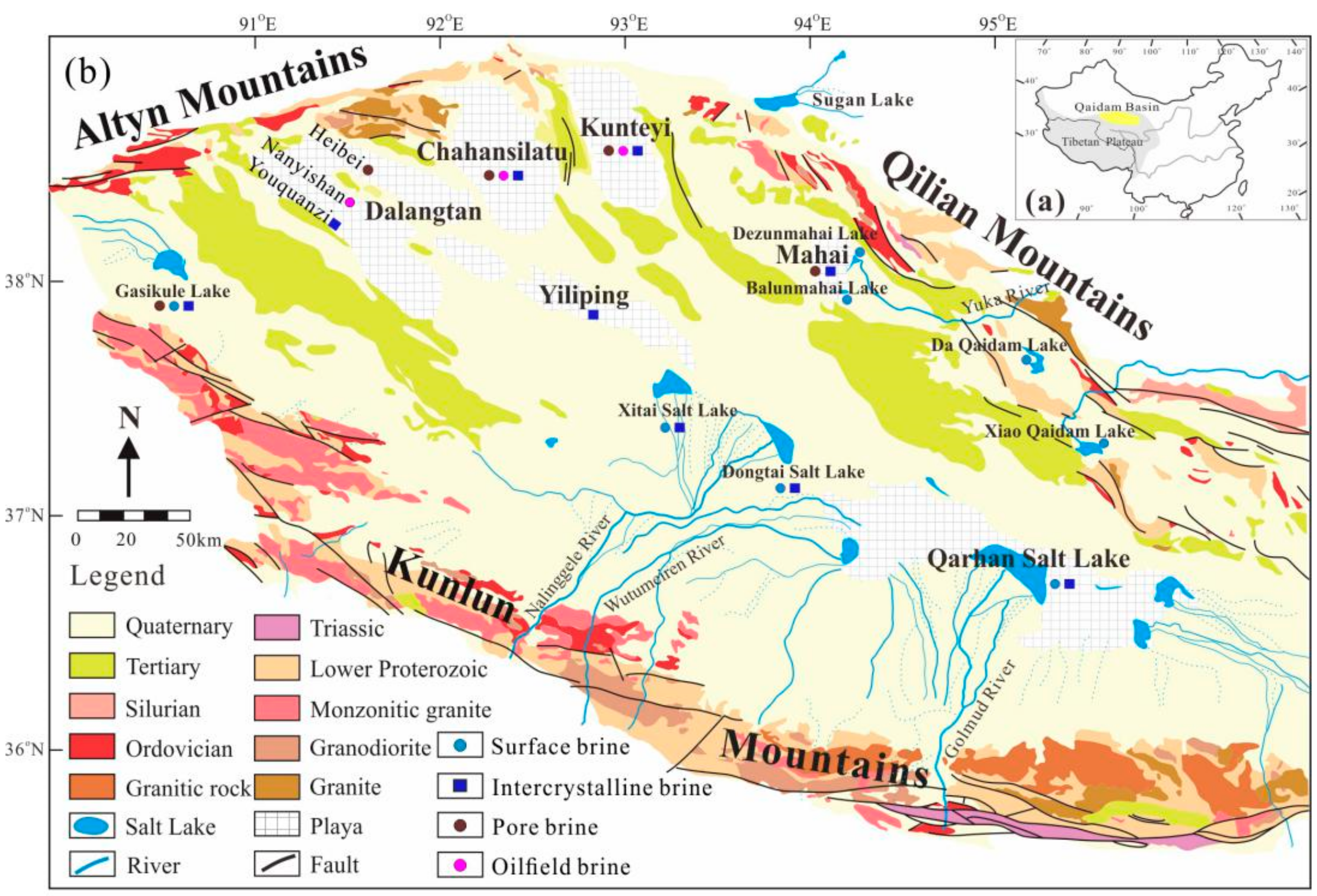
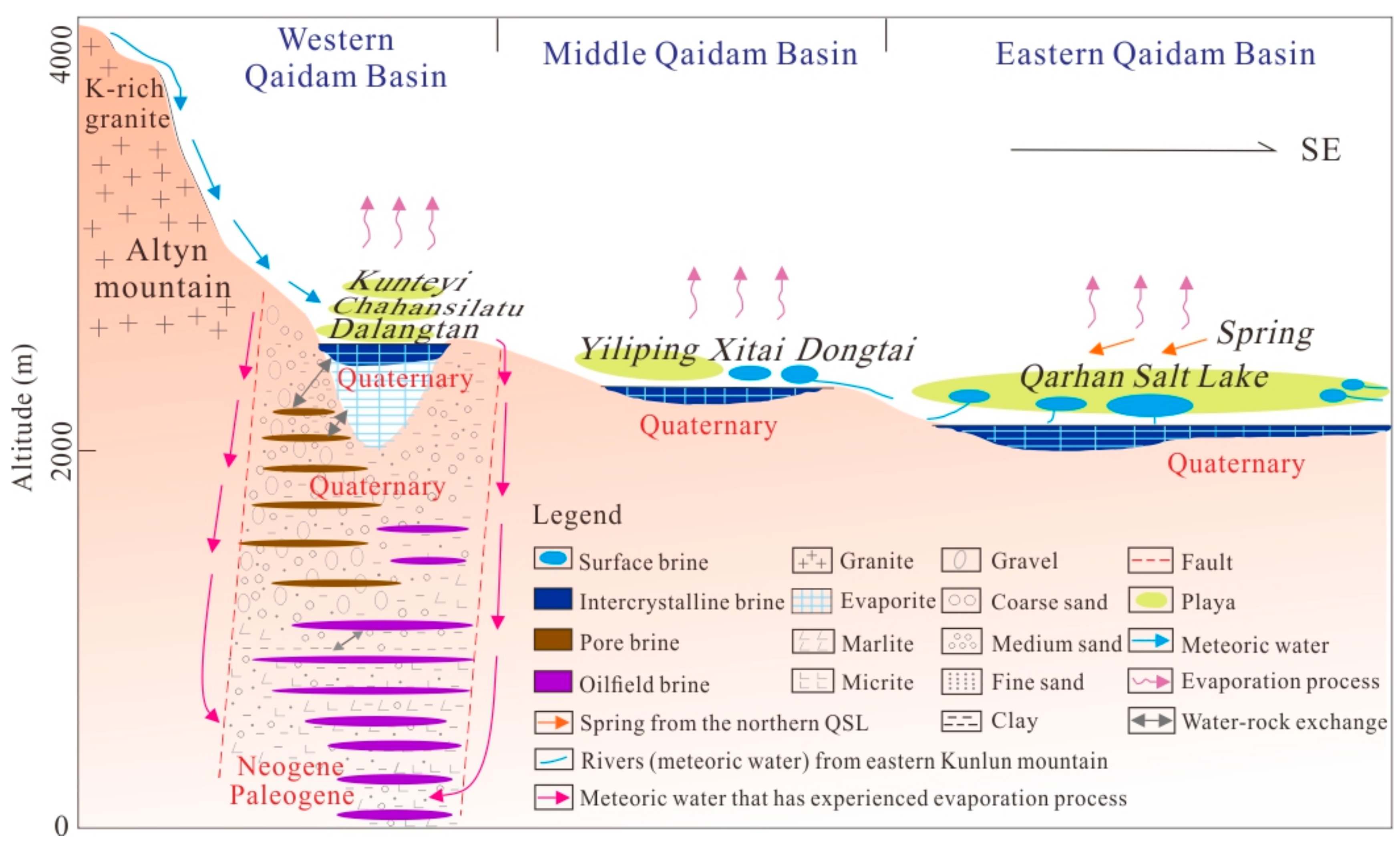
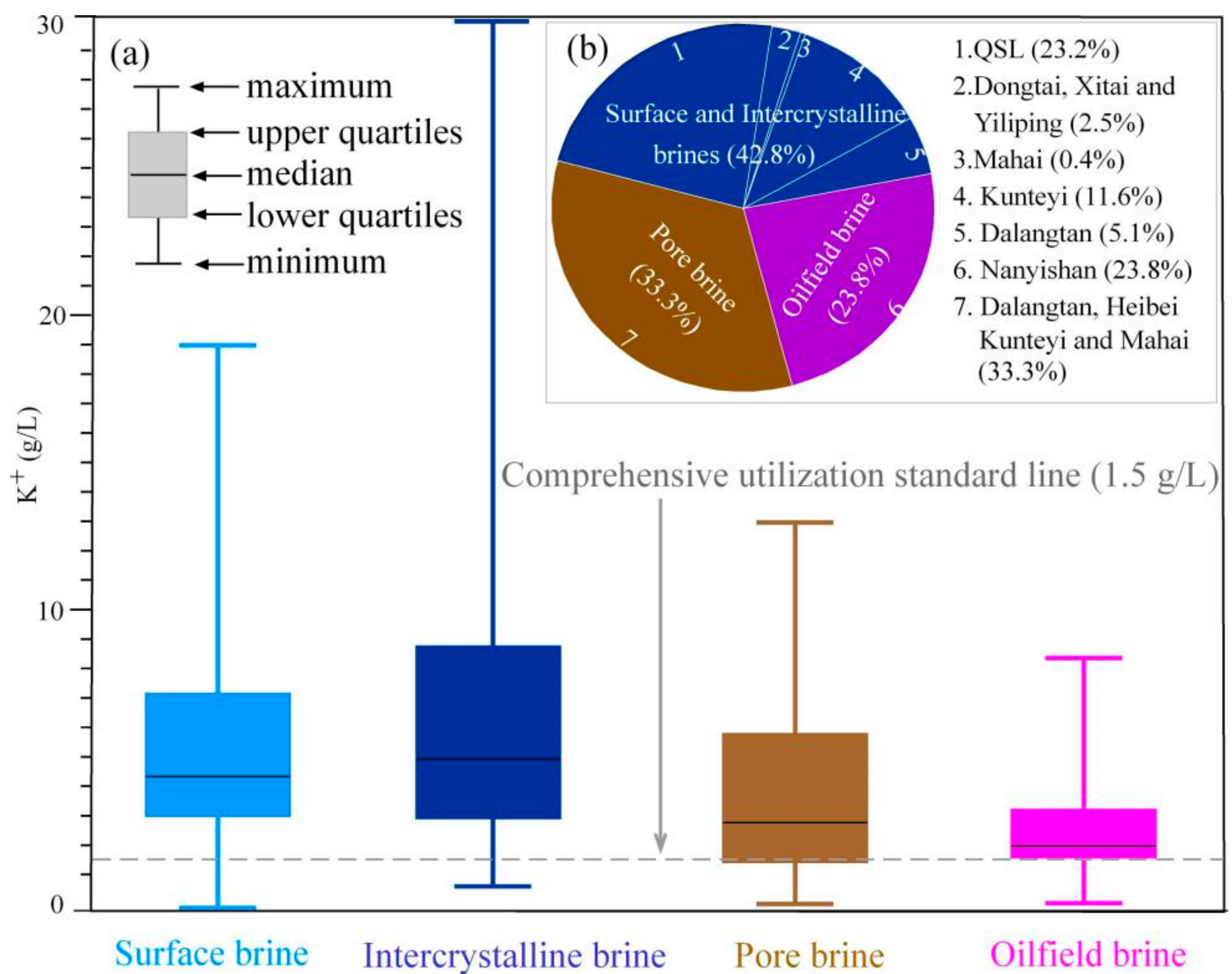
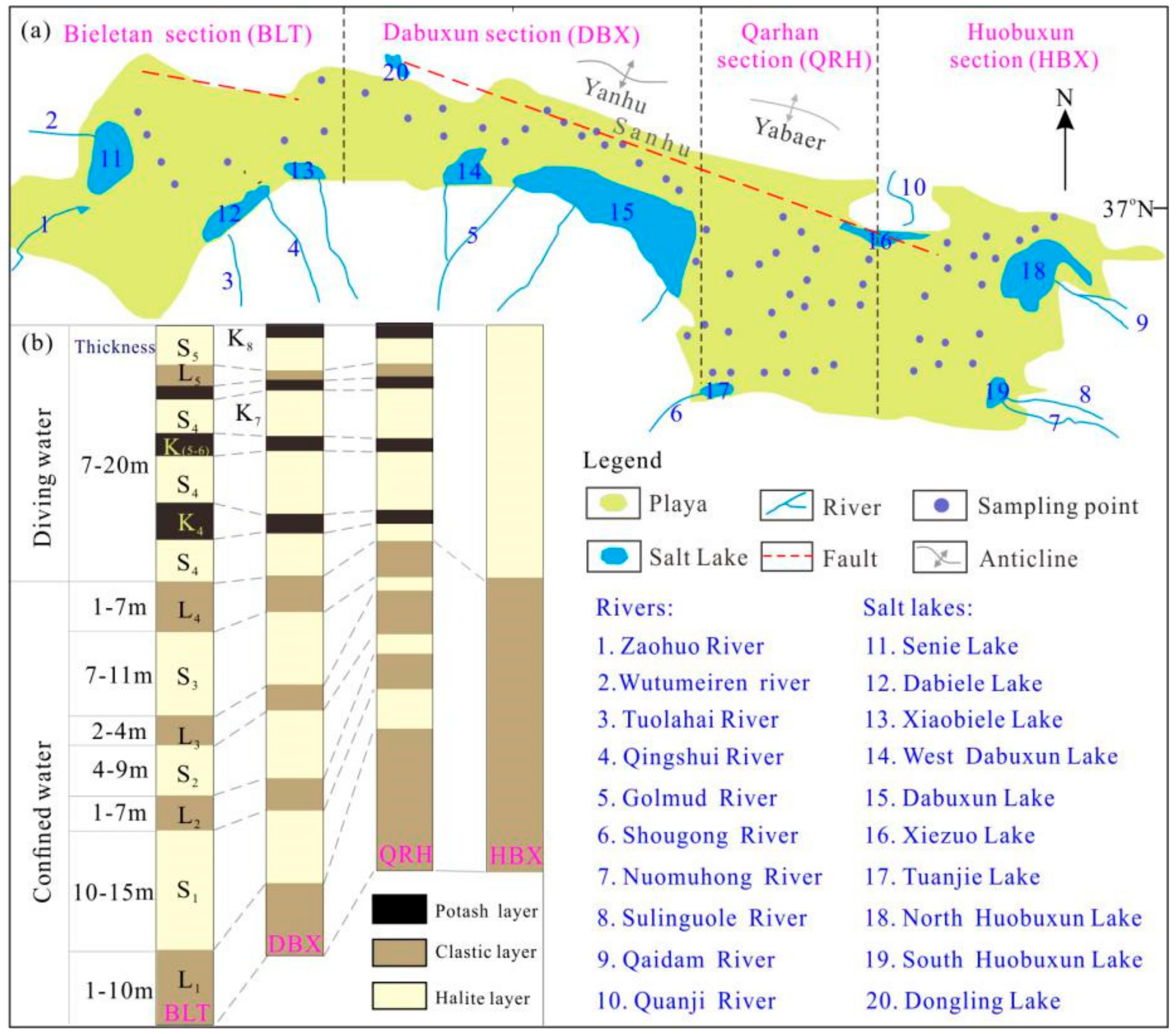
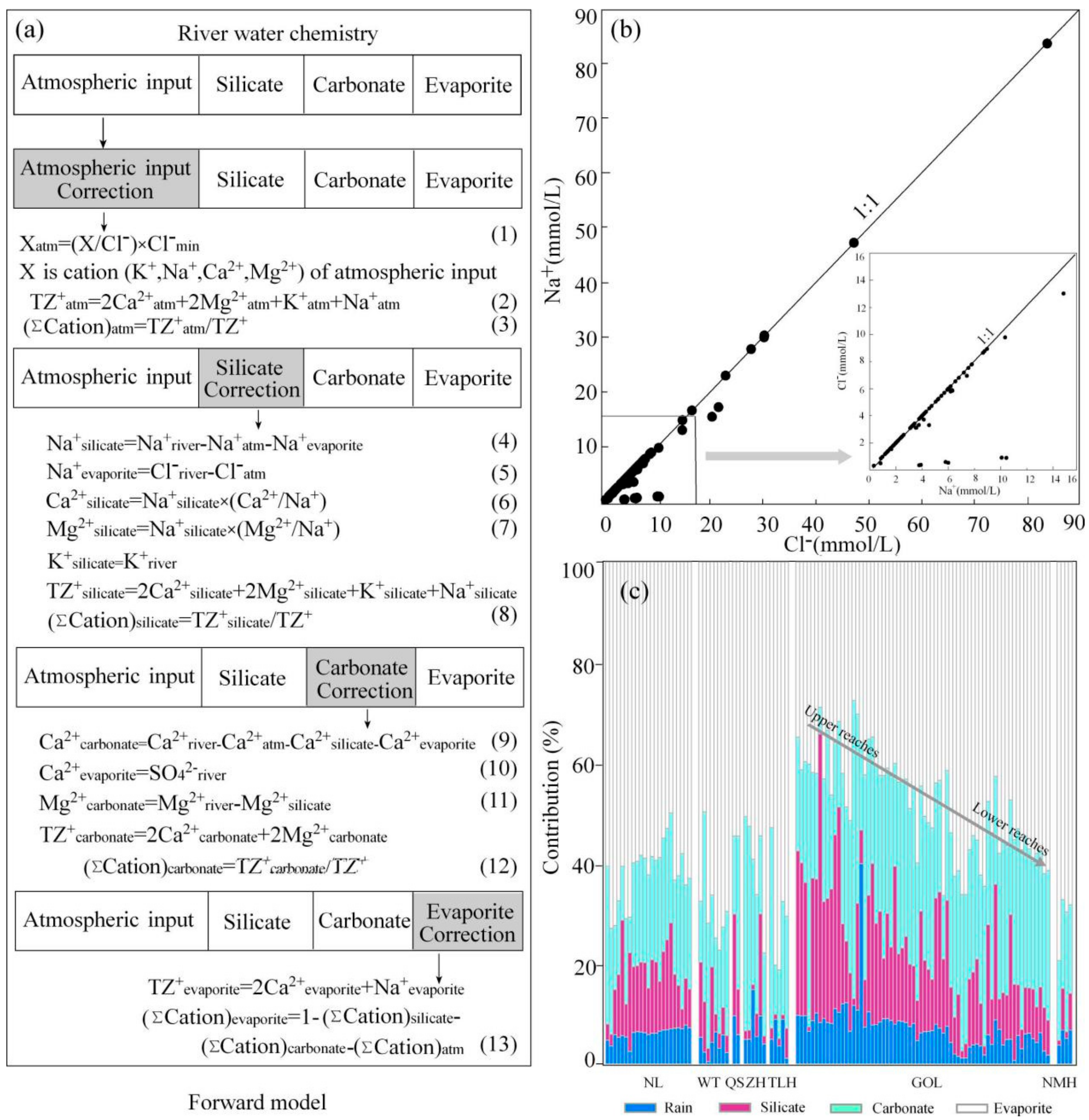
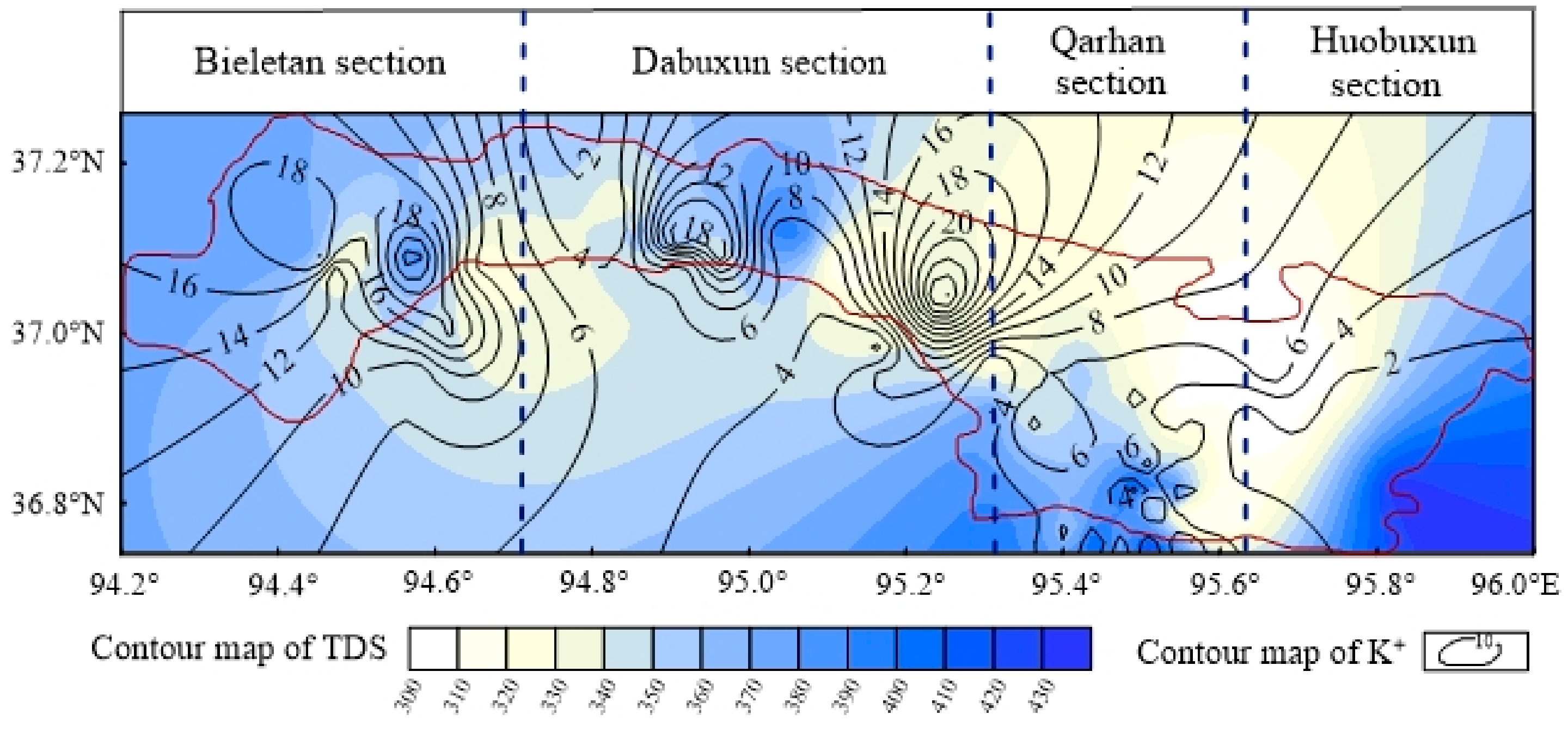
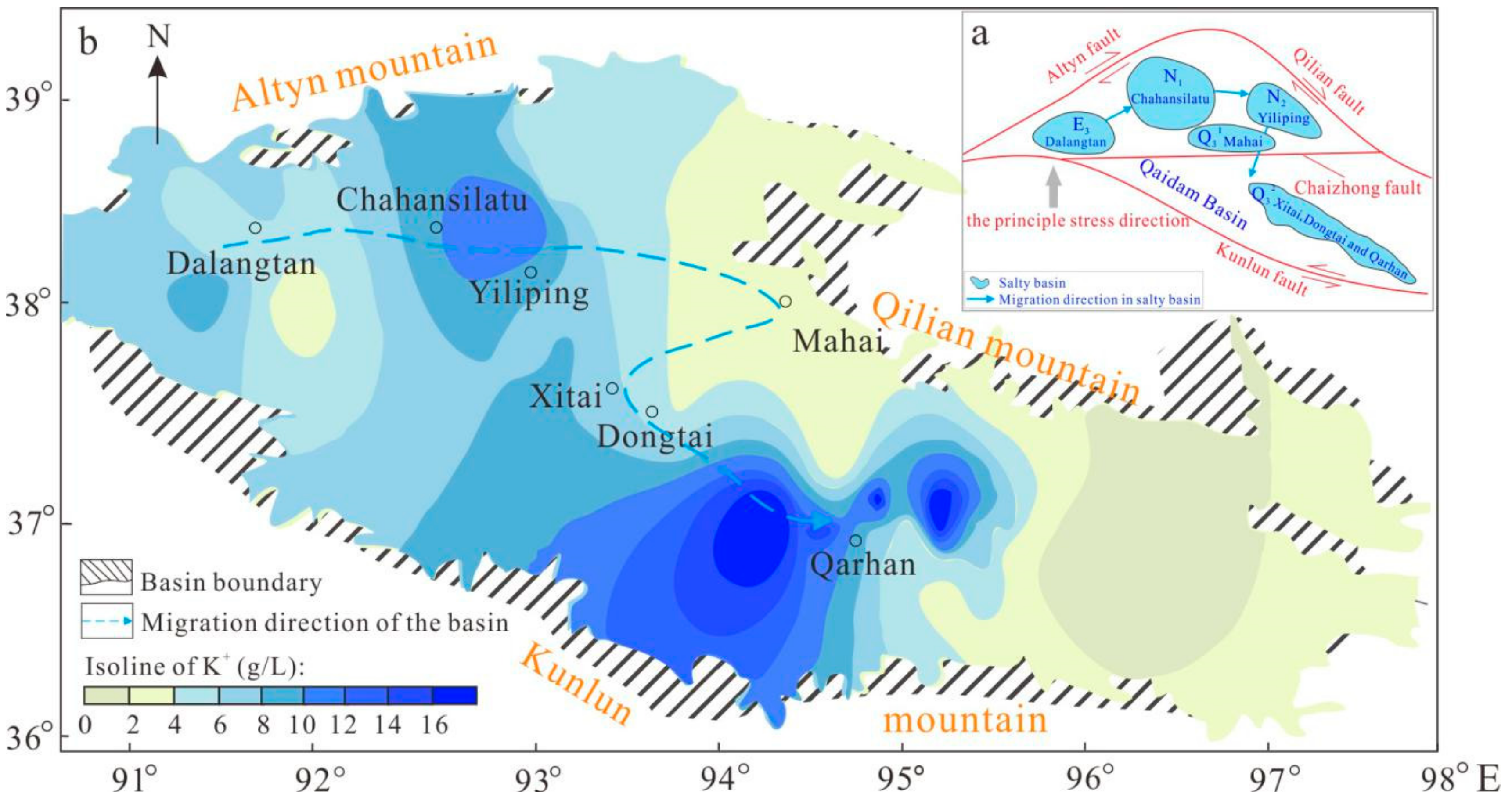

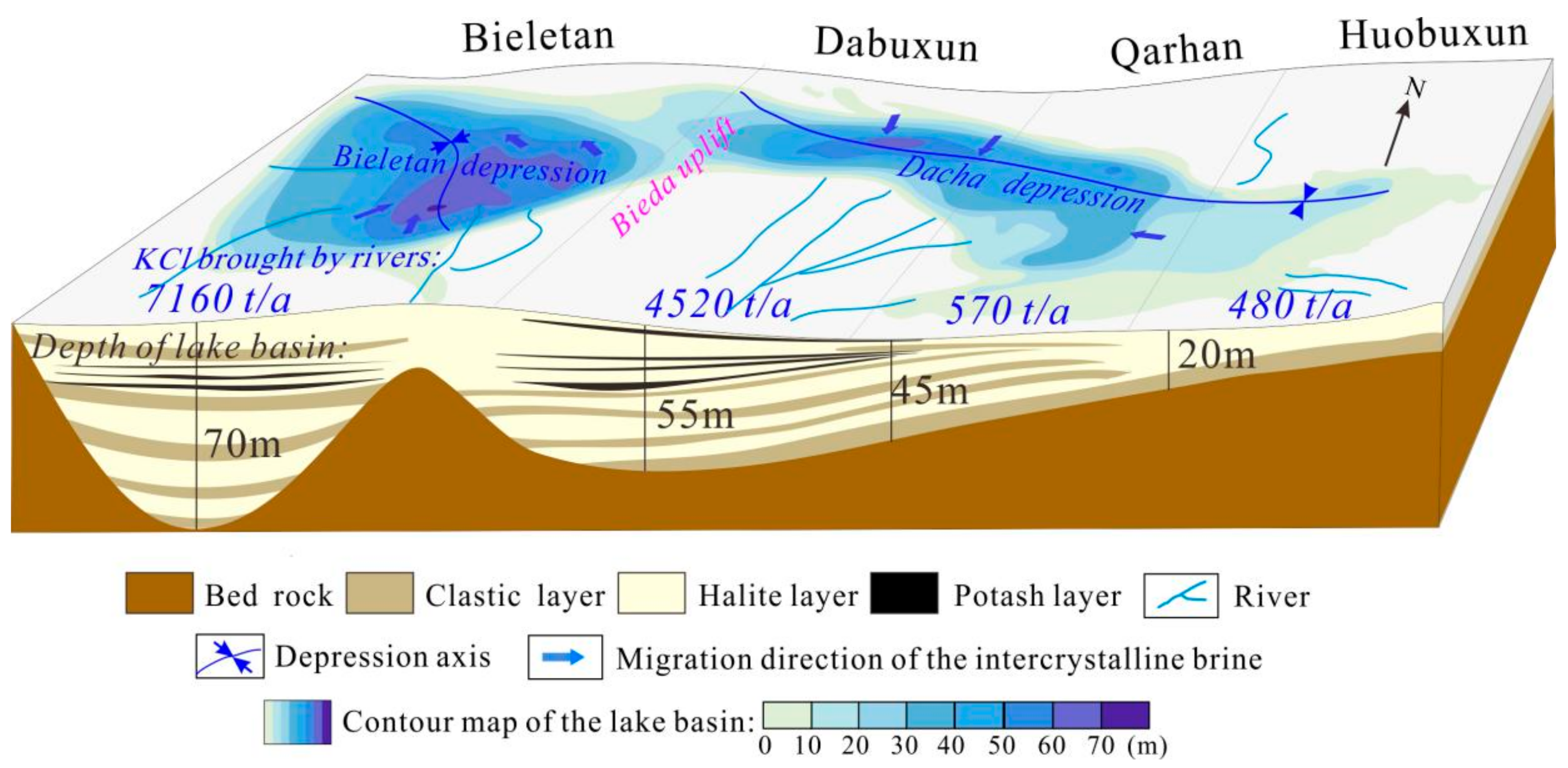
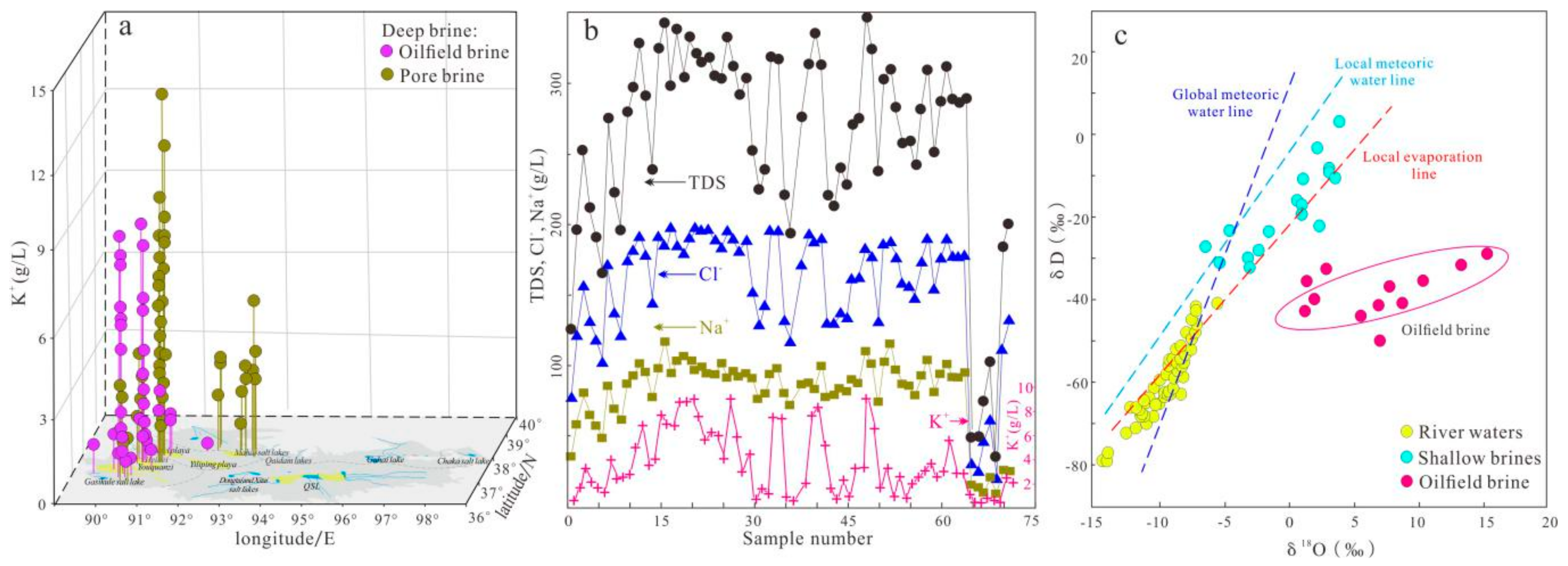
| Sample Site | No. | K+ (g/L) | TDS (g/L) | Sample Site | No. | K+ (g/L) | TDS (g/L) |
|---|---|---|---|---|---|---|---|
| Bieletan | 1 | 11.5 | 336.1 | Qarhan | 33 | 1.6 | 427.0 |
| Bieletan | 2 | 21.1 | 343.9 | Qarhan | 34 | 0.9 | 406.4 |
| Bieletan | 3 | 10.8 | 379.9 | Qarhan | 35 | 0.8 | 416.8 |
| Bieletan | 4 | 10.2 | 320.1 | Qarhan | 36 | 4.1 | 333.3 |
| Bieletan | 5 | 18.5 | 327.6 | Qarhan | 37 | 10.1 | 366.7 |
| Bieletan | 6 | 15.4 | 330.8 | Qarhan | 38 | 2.8 | 337.3 |
| Bieletan | 7 | 26.5 | 393.3 | Qarhan | 39 | 4.4 | 315.2 |
| Dabuxun | 8 | 7.8 | 345.4 | Qarhan | 40 | 4.2 | 327.4 |
| Dabuxun | 9 | 12.7 | 352.1 | Qarhan | 41 | 3.0 | 310.7 |
| Dabuxun | 10 | 20.4 | 352.1 | Qarhan | 42 | 8.9 | 338.6 |
| Dabuxun | 11 | 5.1 | 307.2 | Qarhan | 43 | 3.6 | 314.6 |
| Dabuxun | 12 | 21.0 | 336.7 | Qarhan | 44 | 5.3 | 346.9 |
| Dabuxun | 13 | 8.2 | 338.6 | Qarhan | 45 | 4.5 | 331.5 |
| Dabuxun | 14 | 16.3 | 360.3 | Qarhan | 46 | 10.4 | 330.0 |
| Dabuxun | 15 | 3.0 | 330.2 | Qarhan | 47 | 5.3 | 356.8 |
| Dabuxun | 16 | 1.7 | 315.2 | Qarhan | 48 | 5.1 | 330.6 |
| Dabuxun | 17 | 4.5 | 391.5 | Qarhan | 49 | 3.0 | 312.5 |
| Dabuxun | 18 | 4.8 | 395.0 | Qarhan | 50 | 3.1 | 314.2 |
| Dabuxun | 19 | 3.4 | 352.4 | Qarhan | 51 | 4.6 | 320.4 |
| Dabuxun | 20 | 2.0 | 354.9 | Qarhan | 52 | 1.2 | 435.1 |
| Dabuxun | 21 | 2.0 | 379.7 | Qarhan | 53 | 3.1 | 309.9 |
| Dabuxun | 22 | 17.2 | 329.1 | Qarhan | 54 | 2.8 | 308.3 |
| Dabuxun | 23 | 30.1 | 339.3 | Qarhan | 55 | 5.2 | 325.8 |
| Dabuxun | 24 | 7.2 | 384.6 | Qarhan | 56 | 1.6 | 309.9 |
| Qarhan | 25 | 3.6 | 386.3 | Qarhan | 57 | 1.6 | 309.0 |
| Qarhan | 26 | 1.4 | 416.9 | Qarhan | 58 | 1.8 | 311.0 |
| Qarhan | 27 | 2.5 | 391.5 | Qarhan | 59 | 1.9 | 311.8 |
| Qarhan | 28 | 7.0 | 354.0 | Huobuxun | 60 | 1.5 | 313.6 |
| Qarhan | 29 | 8.9 | 366.5 | Huobuxun | 61 | 13.6 | 367.6 |
| Qarhan | 30 | 1.4 | 434.9 | Huobuxun | 62 | 1.7 | 308.6 |
| Qarhan | 31 | 5.9 | 362.1 | Huobuxun | 63 | 1.8 | 313.2 |
| Qarhan | 32 | 0.8 | 416.6 | Huobuxun | 64 | 1.9 | 311.0 |
| Section | River | Q (m3/a, 108) | C (mg/L) | Total KCl a | Total KCl b | Total KCl c |
|---|---|---|---|---|---|---|
| (t/a, 103) | (t/a, 103) | (t/a, 103) | ||||
| Bieletan | Wutumeiren R | 0.84 | 36.10 | 3.04 | 8.50 | 5.77 |
| Zaohuo R | 0.84 | 13.34 | 1.12 | 0.83 | 0.97 | |
| Tuolahai R | 0.49 | 10.99 | 0.53 | 0.20 | 0.37 | |
| Qingshui R | 0.36 | 3.85 | 0.14 | 0.86 | 0.50 | |
| Total | 4.83 | 10.39 | 7.61 | |||
| Dabuxun | Golmud R | 7.97 | 5.71 | 4.55 | 4.49 | 4.52 |
| Total | 4.55 | 4.49 | 4.52 | |||
| Qarhan | Shougong R | 0.57 | ||||
| Total | 0.57 | 0.57 | ||||
| Huobuxun | Nuomuhong R | 1.54 | 2.70 | 0.42 | ||
| Sulinguole R | 0.06 | |||||
| Total | 0.48 | |||||
| Spring | 3.30 |
© 2019 by the authors. Licensee MDPI, Basel, Switzerland. This article is an open access article distributed under the terms and conditions of the Creative Commons Attribution (CC BY) license (http://creativecommons.org/licenses/by/4.0/).
Share and Cite
Zhang, X.; Fan, Q.; Li, Q.; Du, Y.; Qin, Z.; Wei, H.; Shan, F. The Source, Distribution, and Sedimentary Pattern of K-Rich Brines in the Qaidam Basin, Western China. Minerals 2019, 9, 655. https://doi.org/10.3390/min9110655
Zhang X, Fan Q, Li Q, Du Y, Qin Z, Wei H, Shan F. The Source, Distribution, and Sedimentary Pattern of K-Rich Brines in the Qaidam Basin, Western China. Minerals. 2019; 9(11):655. https://doi.org/10.3390/min9110655
Chicago/Turabian StyleZhang, Xiangru, Qishun Fan, Qingkuan Li, Yongsheng Du, Zhanjie Qin, Haicheng Wei, and Fashou Shan. 2019. "The Source, Distribution, and Sedimentary Pattern of K-Rich Brines in the Qaidam Basin, Western China" Minerals 9, no. 11: 655. https://doi.org/10.3390/min9110655
APA StyleZhang, X., Fan, Q., Li, Q., Du, Y., Qin, Z., Wei, H., & Shan, F. (2019). The Source, Distribution, and Sedimentary Pattern of K-Rich Brines in the Qaidam Basin, Western China. Minerals, 9(11), 655. https://doi.org/10.3390/min9110655





